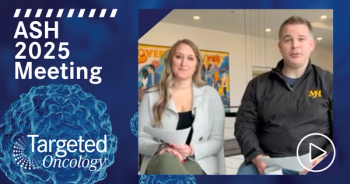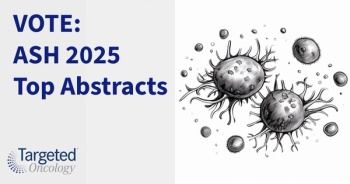
Next Generation Sequencing Shows the Possibility of Primary Resistance in EGFR-Mutant NSCLC
Coexisting driver mutations within EGFR-mutant non-small cell lung cancer (NSCLC) could possibly contribute to primary resistance to EGFR-targeted therapy.
Daniel S. W. Tan, MBBS, BSc, MRCP
Coexisting driver mutations withinEGFR-mutant non-small cell lung cancer (NSCLC) could possibility contribute to primary resistance to EGFR-targeted therapy, according to a presentation that was given during the Presidential Plenary Symposium at this year’s World Conference on Lung Cancer.
"With targeting EGFR, this is something we know works well, and what we're trying to get closer to is defining subsets within that group, so that we can maximize potential responses," stated Daniel S. W. Tan, MBBS, BSc, MRCP, director, Department of Medical Oncology, National Cancer Centre Singapore, during a presentation of the results. “It is likely that additional subgroups within T790M-positive and -negative patients, such as those with high mutation burden, will further emerge, and may form the basis for novel therapeutic approaches, including immunotherapy.”
In the study, whole exome and transcriptome sequencing was conducted on tumor samples from those who were naïve or resistant to EGFR TKIs across two cohorts. In the first group, tissue samples were attained during surgery for patients with stage I/II resected TKI-naïve NSCLC. In this cohort, the excised tumor was divided into sectors (4-11 sectors per tumor), each of which was examined by next-generation sequencing. In a second cohort, biopsy samples were explored from patients with stage IV EGFR TKI-resistant NSCLC.
The primary goal of the study was to determine the clonal architecture of the tumor by using multi-sector sequencing. This information could potentially help illuminate possible causes for varying responses to frontline EGFR inhibition. Additionally, for samples from the second cohort, the study hoped to determine potential mechanisms of EGFR TKI resistance.
Overall, 8 tumors were available for multi-sector analysis, with each containing an average of 54 coding exome alterations. All samples came from patients without a history of smoking, which possibly contributed to an unusually low mutation burden seen in the study, Tan suggested.
EGFRmutations were discovered across all sectors in each tumor, in the "trunk" region, representing a driver mutation. Overall, 5 were L858Rmutations (62.5%), 2 were exon 19 deletions (25%), and 1 was an exon 20 insertion (12.5%). Although ultra-deep sequencing was utilized, T790Mmutations were not detected in any sectors in TKI-naïve patients. Despite the fact thatEGFRwas present within the trunk of all samples, other alterations were also found to coexist, including TP53and PTEN.
When looking at the two cohorts together, two patients in the TKI-naïve arm had expression profiles similar to those in the TKI-resistant arm. In one of these patients withEGFR L858R-mutant stage IB NSCLC, 3 additional driver mutations were identified (CLIP1, PTENsplice site, and MAP3K19). In this example, the patient relapsed within 5 months of surgery.
"This particular tumor had co-existing truncal driver mutations, suggesting that multiple driver events could account for the 10% to 20% of patients who don't respond very well," Tan said. "It is very early data that we're generating and we'll hopefully be generating more data in the future."
In evaluable samples from the second cohort (n = 24),T790Mmutations were the most common resistance mechanism (54%). In T790M-mutant samples, non-overlapping coexisting alterations were seen inMET(8%) and HER2(4%).
In those withT790M-negative tumors, 16% were found to have high mutation burdens, which were associated with a smoking history or APOBEC mutational signatures. In theT790M-negative group, alterations were also seen inMET(13%),HER2(4%), and HER2plus MET(4%).
"We now have third-generation drugs to tackleT790M, but they don't happen in isolation. In this case, this did coexist with bothMETand HER2amplification," Tan said. "More interestingly, when we looked at the subset of resistant tumors, a small group had a higher mutation burden."
Findings from this study could help guide future clinical trials for patients with EGFR TKI-resistant tumors, especially those with a high tumor burden. Early evidence reported at the 2015 ASCO Annual Meeting suggested that tumors with a higher tumor burden were more susceptible to immune checkpoint inhibition.
"With a high mutation burden, we are beginning to get some data with immunotherapy approaches," Tan said. "They may be patients that we could consider for immunotherapy trials."
For those withT790M-mutant NSCLC, there are a number of third-generation TKIs in development. In early August, Clovis Oncology completed a new drug application for rociletinib in patients withEGFR T790M-positive metastatic NSCLC, based on phase I/II TIGER-X trial.
Additionally, during the summer, AstraZeneca submitted a new drug application for osimertinib (formally AZD9291), based on two phase II studies, AURA and AURA2. This application has received a priority review designation from the FDA as a treatment for patients withT790Malterations, and a decision is expected in early 2016.
Click here for more articles:2015 World Conference on Lung Cancer> >
Tan DSW, Nahar R, Takano A, et al. Multiregion whole exome and transcriptome sequencing defines the genomic spectrum of EGFR M+ NSCLC and reveals novel mechanisms of TKI resistance. Presented at: 16th World Conference on Lung Cancer; September 6-9; Denver, CO. Abstract 3637.









































